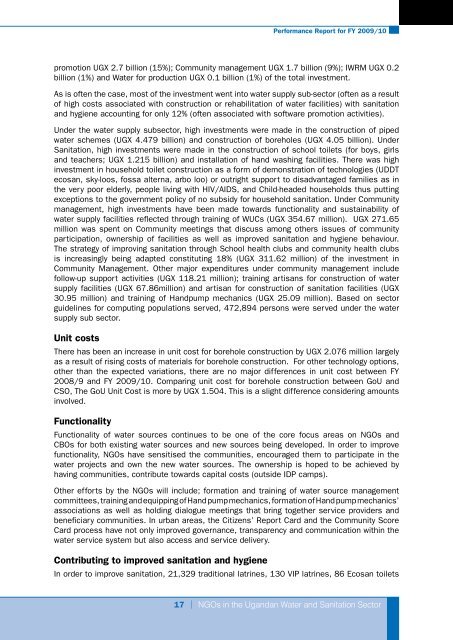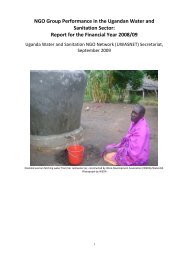Performance Report for FY 2009/10 - UWASNET
Performance Report for FY 2009/10 - UWASNET
Performance Report for FY 2009/10 - UWASNET
Create successful ePaper yourself
Turn your PDF publications into a flip-book with our unique Google optimized e-Paper software.
<strong>Per<strong>for</strong>mance</strong> <strong>Report</strong> <strong>for</strong> <strong>FY</strong> <strong>2009</strong>/<strong>10</strong><br />
promotion UGX 2.7 billion (15%); Community management UGX 1.7 billion (9%); IWRM UGX 0.2<br />
billion (1%) and Water <strong>for</strong> production UGX 0.1 billion (1%) of the total investment.<br />
As is often the case, most of the investment went into water supply sub-sector (often as a result<br />
of high costs associated with construction or rehabilitation of water facilities) with sanitation<br />
and hygiene accounting <strong>for</strong> only 12% (often associated with software promotion activities).<br />
Under the water supply subsector, high investments were made in the construction of piped<br />
water schemes (UGX 4.479 billion) and construction of boreholes (UGX 4.05 billion). Under<br />
Sanitation, high investments were made in the construction of school toilets (<strong>for</strong> boys, girls<br />
and teachers; UGX 1.215 billion) and installation of hand washing facilities. There was high<br />
investment in household toilet construction as a <strong>for</strong>m of demonstration of technologies (UDDT<br />
ecosan, sky-loos, fossa alterna, arbo loo) or outright support to disadvantaged families as in<br />
the very poor elderly, people living with HIV/AIDS, and Child-headed households thus putting<br />
exceptions to the government policy of no subsidy <strong>for</strong> household sanitation. Under Community<br />
management, high investments have been made towards functionality and sustainability of<br />
water supply facilities reflected through training of WUCs (UGX 354.67 million). UGX 271.65<br />
million was spent on Community meetings that discuss among others issues of community<br />
participation, ownership of facilities as well as improved sanitation and hygiene behaviour.<br />
The strategy of improving sanitation through School health clubs and community health clubs<br />
is increasingly being adapted constituting 18% (UGX 311.62 million) of the investment in<br />
Community Management. Other major expenditures under community management include<br />
follow-up support activities (UGX 118.21 million); training artisans <strong>for</strong> construction of water<br />
supply facilities (UGX 67.86million) and artisan <strong>for</strong> construction of sanitation facilities (UGX<br />
30.95 million) and training of Handpump mechanics (UGX 25.09 million). Based on sector<br />
guidelines <strong>for</strong> computing populations served, 472,894 persons were served under the water<br />
supply sub sector.<br />
Unit costs<br />
There has been an increase in unit cost <strong>for</strong> borehole construction by UGX 2.076 million largely<br />
as a result of rising costs of materials <strong>for</strong> borehole construction. For other technology options,<br />
other than the expected variations, there are no major differences in unit cost between <strong>FY</strong><br />
2008/9 and <strong>FY</strong> <strong>2009</strong>/<strong>10</strong>. Comparing unit cost <strong>for</strong> borehole construction between GoU and<br />
CSO, The GoU Unit Cost is more by UGX 1.504. This is a slight difference considering amounts<br />
involved.<br />
Functionality<br />
Functionality of water sources continues to be one of the core focus areas on NGOs and<br />
CBOs <strong>for</strong> both existing water sources and new sources being developed. In order to improve<br />
functionality, NGOs have sensitised the communities, encouraged them to participate in the<br />
water projects and own the new water sources. The ownership is hoped to be achieved by<br />
having communities, contribute towards capital costs (outside IDP camps).<br />
Other ef<strong>for</strong>ts by the NGOs will include; <strong>for</strong>mation and training of water source management<br />
committees, training and equipping of Hand pump mechanics, <strong>for</strong>mation of Hand pump mechanics’<br />
associations as well as holding dialogue meetings that bring together service providers and<br />
beneficiary communities. In urban areas, the Citizens’ <strong>Report</strong> Card and the Community Score<br />
Card process have not only improved governance, transparency and communication within the<br />
water service system but also access and service delivery.<br />
Contributing to improved sanitation and hygiene<br />
In order to improve sanitation, 21,329 traditional latrines, 130 VIP latrines, 86 Ecosan toilets<br />
17 | NGOs in the Ugandan Water and Sanitation Sector



